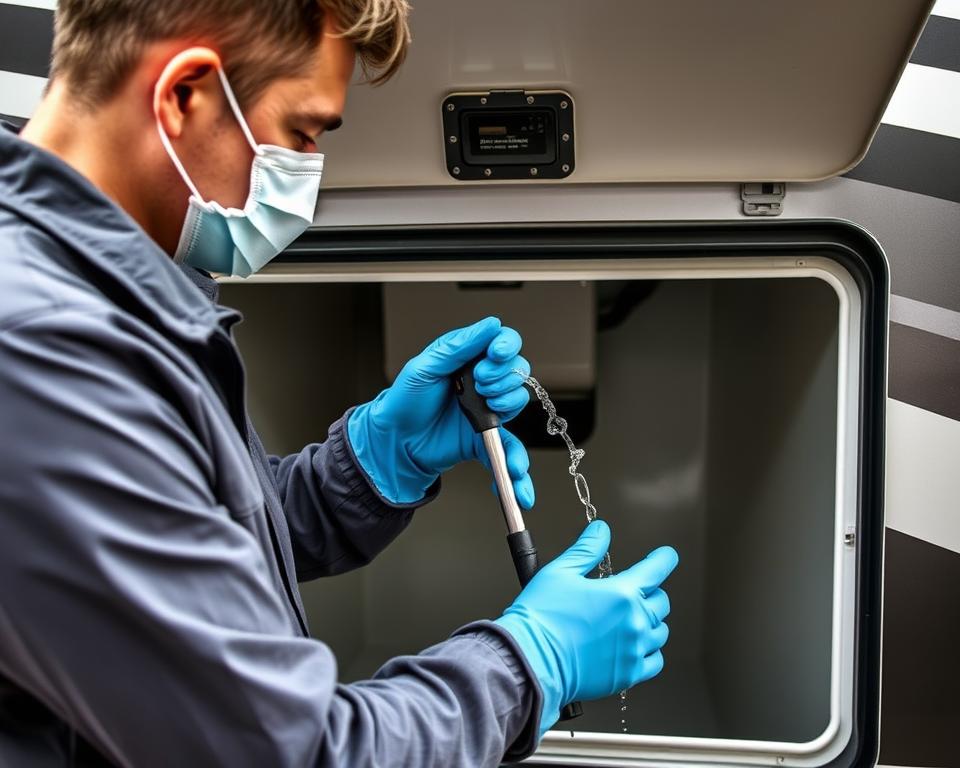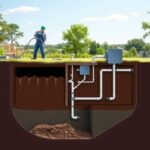Recreational Vehicle Sewage Pump Handbook: Crucial Care Guidelines
Have you given thought to the operation of your camper’s waste disposal system? Understanding the nuts and bolts of your RV sewer pump can prevent mishaps, enhancing your camping excursions. It’s centered on handling waste efficiently and warding off noxious odors. Through this guide, you’ll discover vital maintenance techniques for RV tank pumping service near me. All are created to support your sewer network’s best operation.
Understanding Your Recreational Vehicle Sewage Pump Setup
The recreational vehicle waste pump network is essential for refuse disposal, making outdoor stays more enjoyable. It features two main tanks: the black water tank for solid waste and the grey-water reservoir for water from wash basins and shower stalls. Differentiating these tanks is important to ward off clogs and keep your RV performing optimally.
An camper macerator unit is a widely used solution for refuse disposal. It grinds solid waste into small fragments, streamlining disposal. Alternatively, a classic RV pump is available. It competently moves waste without pulverizing, for those seeking a simpler option.
Knowing your RV’s sewage pumping system is key to stopping problems and ensuring trouble-free evaluations. Managing the system effectively can prevent messes, improving your outdoor adventures.
Significance of Routine Care
Maintaining your RV sewer pump is vital for a trouble-free journey. Without proper maintenance, you may run into odors, clogs, or backups. These glitches can wreck your road trips.
Routine checkups stop such problems and sustain your system’s life. By inspecting hoses and seals, you boost efficiency. A well-serviced RV sewage pump ensures clean waste handling, letting you enjoy nonstop trips.
Ongoing care also yields financial savings over time. Neglect can cause costly breakdowns, requiring high-cost fixes. Putting resources into regular maintenance keeps your motorhome in optimal state, conserving money long term.
How Often Should You Pump Your RV Septic Tank?
Determining the proper interval to service your RV Septic tank is vital for its upkeep. It’s best practice to pump every 72–120 hours during use. For weekend journeys, post-trip emptying may work fine.
Frequency depends on different variables. Tank size and usage level are key. Best practice is to pump when it reaches two thirds. This helps maintain uninterrupted discharge and avoid blockages.
Tracking your RV Septic tank capacity is essential for a smooth journey. Ensure proper management of your camper’s refuse to stop issues while traveling.

Recommended Tank Emptying Tips
Properly emptying RV tanks is crucial for your motorhome’s cleanliness and functionality. Always empty first the black water tank to let the grey water rinse leftover solids. This method prevents clogs and ensures seamless flow.
Opt for a premium drain hose for disposal. A sturdy hose avoids leaks and ensures connections. Use a tank rinser for a deep clean, using water pressure to remove lingering waste, improving cleanliness.
Thorough draining prevents residue buildup, stopping foul odors and potential issues. To maintain an effective sewage system in your motorhome, observe these guidelines:
- Regularly use a tank treatment to control odors and decompose waste.
- Monitor tank levels to avoid leaks.
- Perform routine pump inspections for clogs and wear.
- Deep rinse tanks each month or twice monthly, even during infrequent outings.
Following these methods enhances your sewage system’s durability and efficiency, ensuring memorable excursions.
Keeping Smells and Blockages at Bay
For a enjoyable trip, preventing foul aromas is vital. Keep enough water in tanks to aid in breaking down waste, warding off unpleasant odors. Also, choosing camper-safe TP helps prevent clogs, avoiding backups.
For better sewage management in campers, try enzymatic solutions. These process sludge thoroughly, streamlining care. Ensure vent pipe clearance to keep air moving freely in the plumbing system.
Mindful disposal is key to avoiding tank issues. Refrain from disposing of wipes, feminine products, and paper towels. These non-biodegradable items can cause significant obstructions. Using these practices helps maintain a tidier camping environment.
RV Waste Pump Service Tips
Maintaining your RV’s sewer pump system is crucial for seamless adventures. Inspect dump valve seals regularly to stop seepage. Leaky seals can cause accidents, harming your RV.
To banish smells and maintain cleanliness, sanitizing is vital. Carry out intensive cleans quarterly to prevent buildup, ensuring the system operates smoothly. These steps are essential for maintaining a on-board grinder, promoting extended service and reliable functionality.
Greasing valve components is another vital task. It helps prevent leaks and enhance functionality. Monitoring tank sensors is vital for precise measurements, preventing spillovers and unexpected pump issues. Regularly reviewing these points makes your RV adventures spotless and more enjoyable.
Indicators You Need Expert Pumping
Identifying septic problems ahead can ward off major issues. A tell-tale indicator you need a professional pump-out is delayed emptying. When sinks and toilets take longer to clear, it often points to obstructions. It suggests your system may be full.
Lingering smells are another clear sign of sewage troubles. Bad odors lingering despite cleaning suggest trapped waste. It’s crucial to examine the elbow trap when dumping waste. Remaining waste visibility signals it’s time for expert emptying.
Technicians employ water-jet systems to break up hard obstructions efficiently. Ignoring these warnings can snowball major problems. Therefore, it’s critical to seek help immediately when issues arise.
| Warning Signs of Waste Problems | Suggested Steps |
|---|---|
| Slow Draining | Look for blockages; schedule pro maintenance |
| Lingering Smells | Inspect fittings; schedule pump-out |
| Visible Waste Residue | Contact pump service for thorough cleaning |
Selecting the Ideal RV Waste Grinder
When choosing an RV macerator pump, consider its capacity, durability, and compatibility with your RV’s size. A reliable macerator is critical for efficiently breaking down waste. This is especially true for RVs requiring constant pumping. High-end pumps optimize sewage handling, ensuring a better travel experience.
A range of options cater to varied requirements. For an informed decision, focus on these essential considerations:
- Capacity: Confirm volume capability suits your needs.
- Durability: Choose pumps with robust construction.
- Ease of Use: Choose devices that simplify installation and operation.
- Compatibility: Confirm it matches your fittings.
Investing time in research when choosing an RV macerator pump boosts travel enjoyment and ensures proper sewage disposal.
RV Sewer Pump Troubleshooting
Proper troubleshooting for your RV sewer pump is key in rectifying common sewage issues before they worsen. If you notice slow drainage, surprise blockages, or persistent odors, address promptly. These are clear signs of malfunction requiring attention.
First inspect the pump, its connections, and hoses. Look for any clogs that could slow flow. Ensure inlet and outlet fittings are secure. Also, verify the pump’s power supply for stability.
If basic checks don’t detect the issue, note the pump’s sound. A unit that’s overly noisy or too quiet may have internal damage. Also, check for leaks, as these can worsen sewage problems. With these troubleshooting steps, many RV owners can find and resolve issues early, avoiding costly repairs.
Long-Term RV Sewer Pump Care
For continued reliability, dedicate yourself to regular sewer pump upkeep. Sanitize the system consistently to prevent clogs. Set up and observe a maintenance routine, keeping everyone informed of their roles. This significantly increases your waste system’s lifespan.
Informing yourself and others on proper waste disposal is crucial. This preventss issues and fosters shared responsibility. The result benefits both users and the sewer system.
- Routine inspection of hoses and connections
- Cleaning filters regularly
- Arrange yearly pro maintenance
- Apply recommended conditioners
Sticking to these steps improves your camper’s sewage system’s durability and keeps it functional, making travels more comfortable.
Final Thoughts
Caring for your RV sewer system diligently is key for uninterrupted camping adventures. Regular attention to RV sewer system maintenance drastically lowers problem risks, letting you focus in the journey. By knowing your system and using reliable sewage methods, your trips will be free of waste management woes.
Implementing the vital tips from this guide enhances RV waste management and advances your travel comfort and safety. Maintain peak performance by following best upkeep practices and resolving potential issues promptly.
Staying vigilant about your RV sewer system pays off. It ensures homely comforts while exploring. Cheers to joyous and relaxed journeys!
Frequently Asked Questions
How do I know when it’s time to pump my RV Septic tank?
Empty your RV Septic tank once it’s two-thirds full.
How do black and grey tanks differ?
Black tank is for sewage waste. Whereas, the grey tank collects water from basins and showers.
When to service my RV sewer pump?
Check seals, sanitize, and clean quarterly.
Which products are best for RV sewer pump care?
Choose RV-approved enzyme formulas and quality hoses and rinsers.
What prevents blockages in RV plumbing?
Use only RV-safe toilet paper.
What signs indicate I need professional RV pump-out?
Watch for slow drainage, recurring odors, or visible residue in the elbow.
How can I improve my RV macerator pump’s efficiency?
Select a correctly sized pump for your RV.
What should I check during a deep clean of my RV sewer system?
Flush lines, replace seals, and sanitize components.
Guidelines for extended RV pump care?
Adopt regular deep cleans and consistent sanitation.
How often should I empty my RV Septic tank with regular use?
Empty every three to five days.

